My 2015 calendars arrived, and they look fantastic. I will start shipping orders this week.
Click to order your 2015 Art in Nature Adventure Series Calendars now!
Limited supplies, order soon!
~ ~ ~
There is an ecstasy that marks the summit of life, and beyond which life cannot rise. And such is the paradox of living, this ecstasy comes when one is most alive, and it comes as a complete forgetfulness that one is alive. This ecstasy, this forgetfulness of living, comes to the artist, caught up and out of himself in a sheet of flame; it comes to the soldier, war-mad on a stricken field and refusing quarter; and it came to Buck, leading the pack, sounding the old wolf-cry, straining after the food that was alive and that fled swiftly before him through the moonlight. He was sounding the depths of his nature, and of the parts of his nature that were deeper than he, going back to the womb of Time. – Jack London, Call of the Wild
For me, like Jack London’s Buck, there’s only one place where such ecstasy is to be found: wilderness. Though it was pure coincidence, Aubrey and I celebrated the 50th anniversary of the wilderness act by spending two weeks backpacking through the Arrigetch Peaks of Alaska’s Brooks Range in Gates of the Arctic National Park. Combined with the neighboring Noatak Wilderness Area, there are over 22,000 square miles of true wilderness there. No roads, no trails, and certainly no cellular networks or internet. Grizzly bears outnumber the people.
With the exception of long rafting trips, access to this area (and most other parts of the park) requires chartering a bush plane. The easiest access is through Bettles, a small town (year-round population of 12) that is itself only accessible by plane. We started our trip at pump-station five, partway along the Dalton Highway, which parallels the Trans-Alaska Oil Pipeline from Fairbanks to Prudhoe Bay, where we were picked up by Brooks Range Aviation for the 10 minute flight to Bettles.
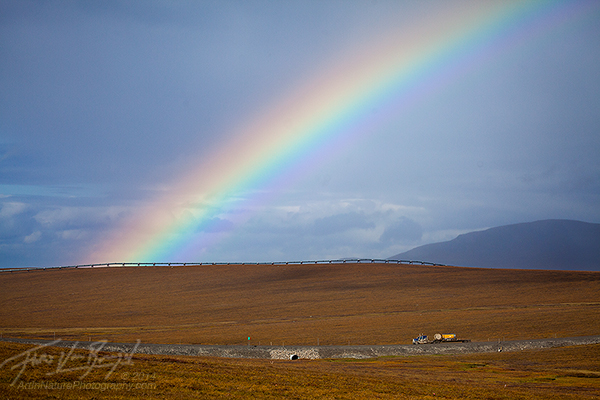
A truck drives down the Haul Road (Dalton Hwy), with the Alaska Pipeline in the distance.
We spent the afternoon organizing our gear and sorting food. We would be carrying 16 days of food with us, which for a hearty 3,500 calorie-per-day per-person diet comes out to about 35 pounds of food, each. The park requires using bear proof canisters, so we had to squeeze all that food into two large and two medium cans, which was not easy considering that the volume was designed for a total of 24 person-days of food, not 32. But with our careful food choices and packing we got everything in: 7 sausages, 3 pounds of cheese, lots of dehydrated beans, rice, dehydrated pasta sauce, instant grits, ramen, 5 pounds of homemade energy bars, 5 pounds of dried fruit and nuts, 3 pounds of chocolate, 3 pounds of coconut butter, a liter of olive oil, and more. This was the longest trip we have had to plan and pack for thus far, and we didn’t want to under, or over, estimate what we would need. At the end of the trip we found we had hit the mark perfectly, with just a day or two of food left over that we had reserved in case we got stuck in bad weather waiting to be picked up.
In addition to the food, we had the rest of our gear of course. A stove, two light pots, seventy ounces of fuel, a 4-season tent, an 8 oz tarp, 20° down sleeping bags, sleeping pads, warm layers, rain gear, emergency gear, crazy creek camp chairs, a sat phone, a gps, extra batteries, and, how could I forget… my camera gear. Somehow everything did fit into our 85 liter packs, with just the camp chairs strapped to the outside. I did have to leave an extra water bottle behind, though.
The following morning we met our pilot and took off in a de Havilland Beaver float plane for a 45 minute flight over the foothills of the Brooks Range. The pilot weaved in and out of narrow mountain passes until finally circling down into the Alatna river valley and landing on Circle Lake, which was more of a pond than a lake. We strapped on our packs, and hopped onto the shore. We watched our pilot take off, and breathed a nervous sigh of relief. We were now about as alone as you can get in the modern world, and would be for the next two weeks.

Aubrey steps off the float plane, into the wilderness.
There are no (official) trails in Gates of the Arctic National Park, and the going is slow. For the first 3-4 miles we wrestled our way through the orange and red bushes until finally coming upon a game trail turned boot-track. After a few more miles, we called it a day and set up camp. The following day, after caching one of the 20 lb bear cans (to be picked up later in the trip), we made it up to the base of the peaks.
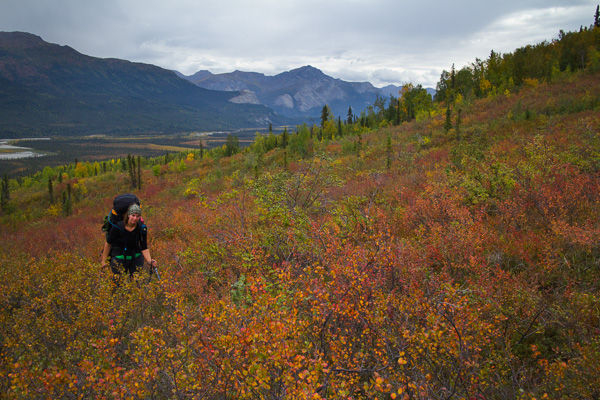
Aubrey makes her way through the bushes above the Alatna river valley.
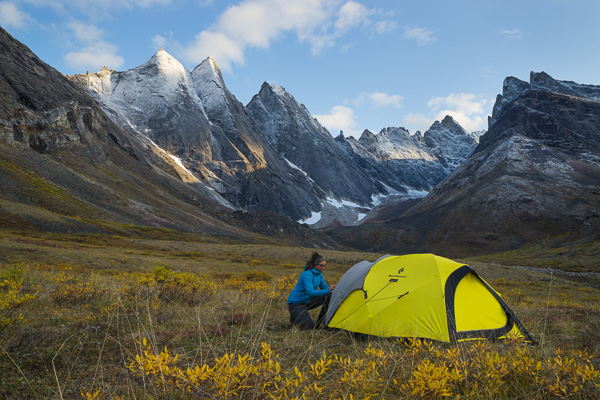
Our spectacular campsite under the Arrigetch peaks.
Although we left as much technology behind as possible, we did bring a satellite phone, which was necessary to communicate with our pilot and also allowed us to get daily weather updates from Aubrey’s father back in Seattle (thanks!!!). The weather was deteriorating, so we decided to stay put for a few nights. The temperatures dropped quickly, and it was clear the season was already starting to transition from fall into winter (it was still late August, mind you).
Click image for larger view!
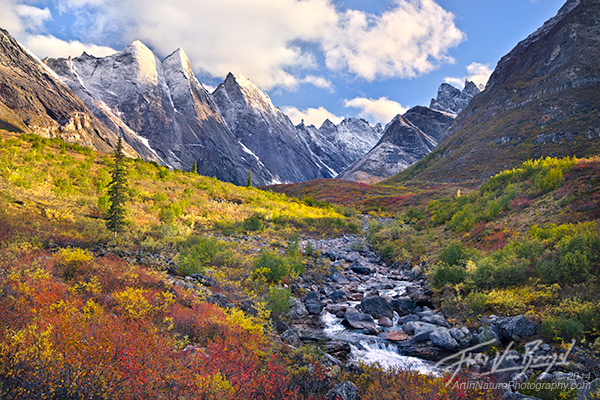
Arctic Transitions : Prints Available
Autumn color in late August, together with the season's first dusting of snow, make for a spectacular view of the Arrigetch Peaks region of Alaska's Brooks Range, deep in the Gates of the Arctic National Park.
On our second morning, while eating our cheesy bacon grits under our cooking tarp, we had our first visitor: a grizzly bear, who Aubrey named Walter. We quickly grabbed the bear spray (powerful pepper spray) and told him to run off, trying our best to hide the trembling in our voices. The bears in that area are still truly wild, and haven’t yet had the pleasure of tasting bacon. So, Walter ran off to go dig up ground squirrels on the other side of the creek.
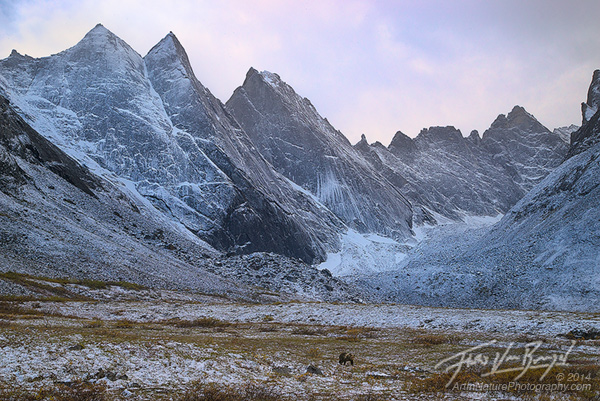
On the Prowl : Prints Available
A grizzly bear (click for larger image), looks for ground squirrels near our backcountry camp below the imposing peaks of Alaska's Brooks Range in Gates of the Arctic National Park.
On our third morning the weather cleared out, and I crawled out of the tent before sunrise to scramble up to a high point for view of the surrounding peaks. The temperatures at night had started to drop into the high teens, and the plants were covered in crystalline layers of hoar frost that crunched satisfyingly underfoot.
Click image for larger view!
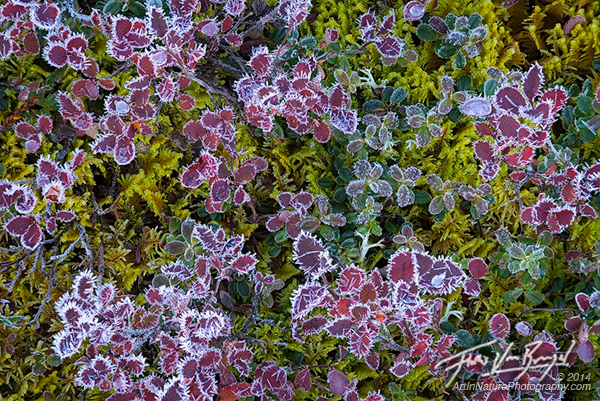
Blueberry Frosting : Prints Available
Hoar frost coats the red leaves of a blueberry bush in the mossy landscape of Alaska's Brooks Range.
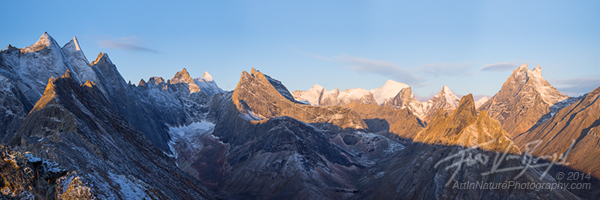
Arrigetch Peaks : Prints Available
The Arrigetch Peaks, at sunrise, seen from a high ridge about a thousand feet above my backcountry campsite. The Arrigetch Peaks are part of Alaska's Brooks Range, and protected as wilderness by the Gates of the Arctic National Park.
With clear skies overhead, it was time to pack up and move camp. We picked our way through mile upon mile of granite boulders, skirting along a chain of small lakes until we finally arrived at the end of a valley, surrounded by the most imposing granite spires I’ve ever seen (yes, even more impressive than Patagonia, I thought!). I was so thrilled by the landscape surrounding us that I was determined to camp right there. We found a large flat boulder and pitched the tent. That evening I headed up towards the base of the peaks to explore. The previous night and day had been quite cold, forming 12 inch long fingers of ice on the stream. The stream had since stopped flowing due to a lack of meltwater, leaving the ice fingers floating in the air, attached only by a precarious connection to the rocks in the stream bed.

Aubrey, climbing up the talus slopes along the valley of aquarius.
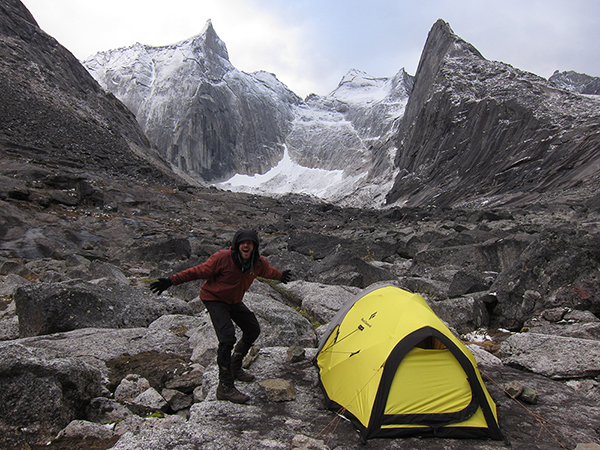
Me, thrilled with the view surrounding our campsite!
Click image for larger view!
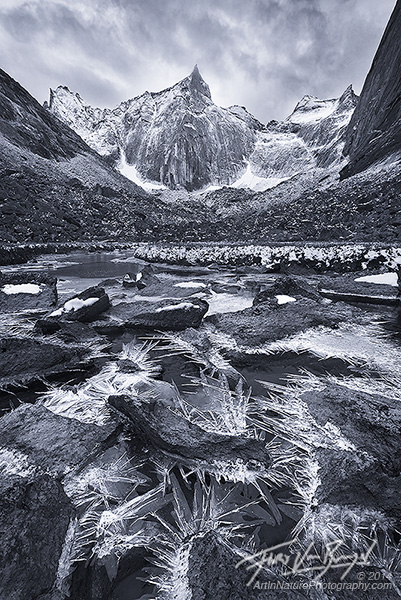
Claws of Winter : Prints Available
Ice crystals up to 12 inches long form along a small creek in a remote valley of the Brooks Range of Alaska, in the Gates of the Arctic National Park.
One of the reasons I had picked this area, and this time of year, was to have a chance at seeing the aurora borealis, aka the northern lights. The Arrigetch Peaks are located right in the middle of the belt of aurora activity, and on just about any clear night the sky comes alive. Of course, clear and dark nights are hard to come by in the mountains this far north. Starting in late August, however, it gets just barely dark enough for an hour or two. Around dusk clouds had started to move in, but I set my alarm nevertheless. Weather moves quickly in the mountains, and there was no telling what might happen in a few hours. When I woke up, the skies were (partially) clear, and there, directly above us, the lights were dancing across the sky!
What is aurora? Electrons and positive ions expelled by the Sun are trapped by the Earth’s magnetic fields, directed towards the poles, and accelerate through the upper atmosphere where they collide with oxygen and nitrogen atoms. These collisions raise the energy level of the electrons inside the atoms, and after a short time, they return to their natural, stable, level, emitting photons in the process (thereby conserving the total energy). The photons are what we see as the dancing lights, and can be colored green, red, pink, blue, and yellow, depending on the level of energy, and the type of atoms. The basic principles of physics at play here are similar to what also happens during fluorescence, which I’ve discussed at length in a previous post: Moonlight Fossicking.
I should admit that to the naked eye the lights were not nearly so colorful as the camera was able to record in a three second exposure. Perhaps on darker (more wintery) nights, the colors are more obvious. Still, it was thrilling to see the lights as the danced across the sky to a silent beat dictated by the suns solar activity 93 million miles away.
Click image for larger view!
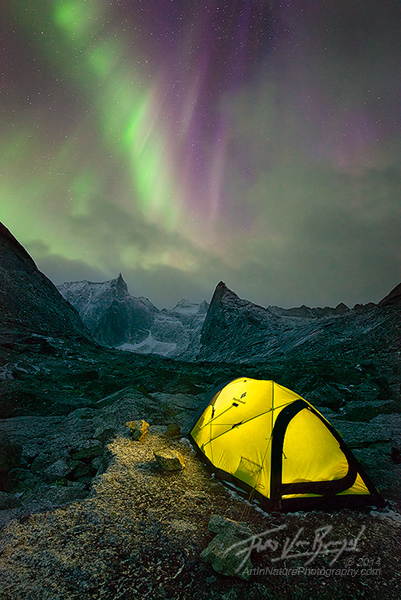
Boreal Nights : Prints Available
The aurora borealis, aka the Northern Lights, dance over my tent (illuminated from within by my girlfriend) in our remote backcountry campsite in the Arrigetch Peaks of Alaska's Brooks Range, deep in the Gates of the Arctic National Park.
The next day we explored the surrounding area, scrambling up the talus ridges in search of inspiring views. We stumbled on the most spectacular campsite either of us had ever seen. We just had to camp there, so we hiked back down to our tent, packed up, and moved everything a quarter mile up the ridge.
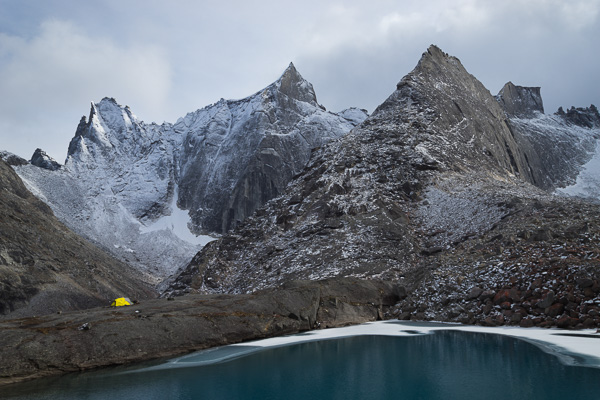
Our tent, surrounded by the epic granite spires of the Arrigetch peaks.

Aubrey, wondering where all this snow came from.
That night more weather blew in, with high winds, and a significant amount of snow fall (at least, for August). We whipped up some instant butterscotch pudding, crawled in the tent, and read Call of the Wild. It’s times like these that I’m glad we packed the 7 lb tent. Even with 60+ mph gusts buffeting the tent, we were warm and safe inside. The next morning the weather hadn’t abated, and we were worried that continued snow, and ice forming from melt-freeze cycles, would make traversing the talus slopes increasingly more dangerous. We packed up and made the long journey back to the safety of the valley below.
Click image for larger view!

Misty Mountains : Prints Available
A clearing storm reveals the majestic snow-capped peaks rising out of the mist in the Arrigetch Peaks region of Alaska's Brooks Range, deep in the Gates of the Arctic National Park.
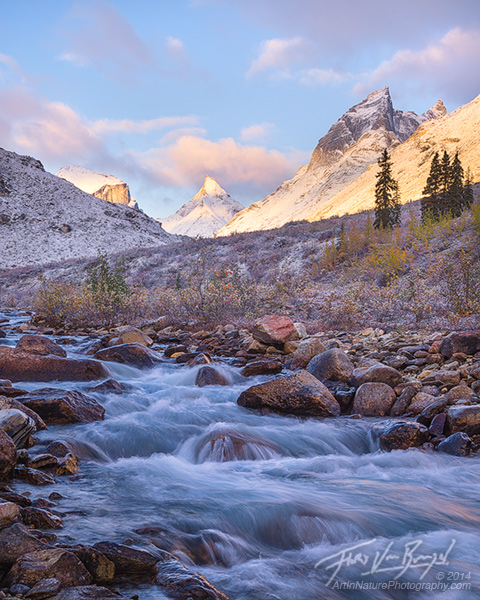
Snowy Arrigetch Morning : Prints Available
Sunrise over the Arrigetch Peaks (center: Ariel Peak) after a fresh dusting of snow in Alaska's Brooks Range, deep in the Gates of the Arctic National Park.
After two days of inclement weather, the skies cleared, and we started hiking up the main Arrigetch Creek drainage, toward the picturesque Arial peak. The weather report, to our delight and surprise, said we should expect the rest of our trip to be clear and sunny during the day, and bitter cold at night. Even at noon though, the northern sides of the canyons got hardly any sunshine and snow from previous days lingered. The temperature contrasts between the shady and sunny sides of the canyon were like night and day, as much 30° F. These exceptional contrasts meant our boots – summer hiking / mountaineering boots – would get soaked with melting snow during the day, and freeze solid every night. Same, of course, with our socks. Realizing it was pointless to put on precious dry socks (I had 3 pairs for the whole trip) only to have them get soaking wet during the day, I took to putting my wet socks in a plastic bag at night which I kept in my sleeping bag. Every morning I would take off my sacred sleeping socks, and don my warm but wet hiking socks, and wriggle my soggy feet into my frozen boots. Three hours later the leather boots would typically thaw out and I would finally start to feel my feet again.
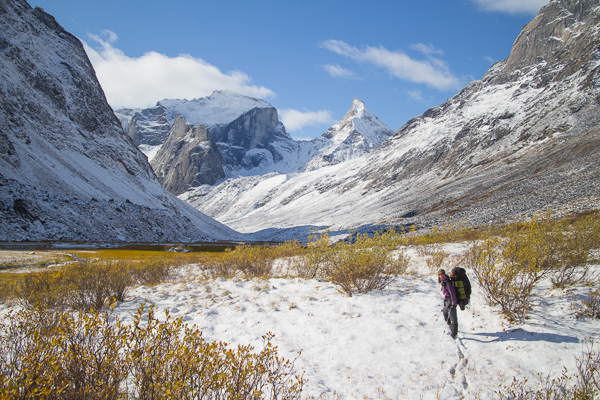
Aubrey hiking up the Arrigetch creek drainage towards Arial peak.
The blanket of snow across the talus slopes made hiking difficult, and forced us to abort an attempt to camp higher up in the valley. We pitched the tent on a nice flat area with great views of the snow-crusted peaks surrounding us. As soon as the sun went down the cold started to set in. The forecast for that night was 20° F or so, but when we awoke at 1 am to see the aurora my thermometer read 9° F. We made some honey-ginger tea, a gift from our friends in Anchorage, and watched the dancing lights from the comfort of our sleeping bags. After an hour or so Aubrey went back to sleep, and I forced my feet into my frozen boots to walk down to the river for some more photographic options.
Click image for larger view!
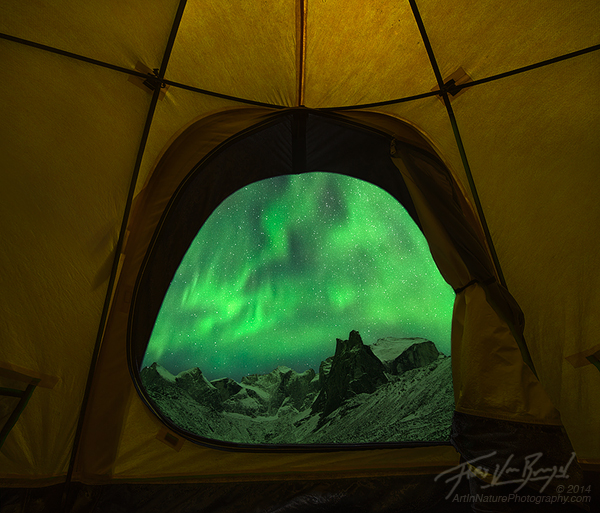
Northern Nights : Prints Available
Watching the northern lights (aurora borealis) dance above the imposing peaks of Alaska's Brooks Range while snuggled in our tent was a most memorable experience. The arctic at its most impressive!
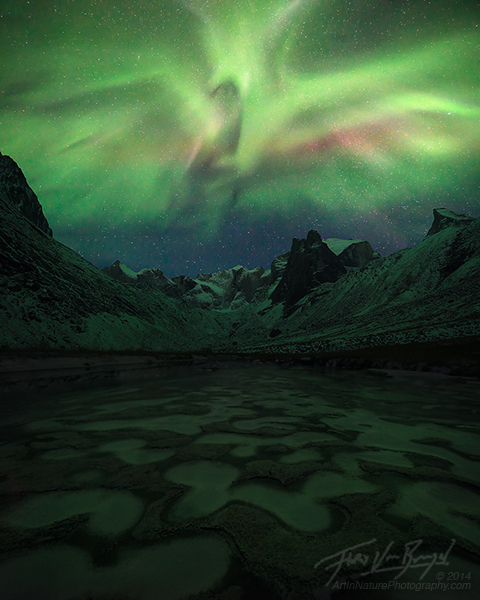
Arctic Angel : Prints Available
A spectacular display of the Aurora Borealis (Northern Lights) overhead in the Brooks Range of Alaska, deep in the Gates of the Arctic National Park.
The next morning we waited impatiently in the warm safety of the tent until finally the sun crested the mountains at 10 am. Our boots were so frozen that to put them on we had thaw them out by putting water bladders filled with boiling water inside them. The forecast for the next night was 14°, which based on the pattern thus far meant we would likely be facing a 5° night if we stayed put. With proper winter sleeping bags and footwear this would be no problem, but we had our 20° summer sleeping bags and boots. It was time to head down below tree line, hopefully below snow line, where we could have a small fire to dry out.
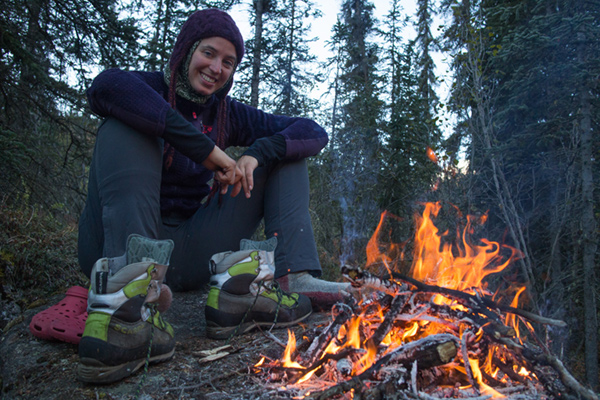
Aubrey thaws her boots by the fire.
Up until now, the trip had been cold, but relaxing. We’d spent half of our days waiting out storms, leisurely exploring the peaks, reading Jack London, and drinking hot chocolate fortified with coconut butter. With a long spell of high pressure ahead of us, and lightened backpacks, it was time to put in some miles to get to our pickup point: Takahula Lake, about 20 miles away. It was here, also, that we left the more established game trails and boot tracks, for this was a route that far fewer visitors took.
We did our best to join short sections of game trails, carved out over the years, perhaps even decades, by the bears, moose, and wolves that call this place home. At times, though, the bushes were so thick that finding a trail of any kind, no matter how faint, was hopeless. The best strategy was to put your head down (to protect your eyes), and just wrestle your way through the alder, channeling your inner bear, or dominant primordial beast as Jack London would call it. Although it was written in reference to a city dog adjusting to his new place among the tough conditions of life as a sled dog in the upper Yukon, this quote captures much of our progression over the next three days of bushwhacking.
The dominant primordial beast was strong in Buck, and under the fierce conditions of trail life it grew and grew. Yet it was a secret growth. His newborn cunning gave him poise and control. He was too busy adjusting himself to the new life to feel at ease, and not only did he not pick fights, but he avoided them whenever possible. A certain deliberateness characterized his attitude. – Jack London, Call of the Wild
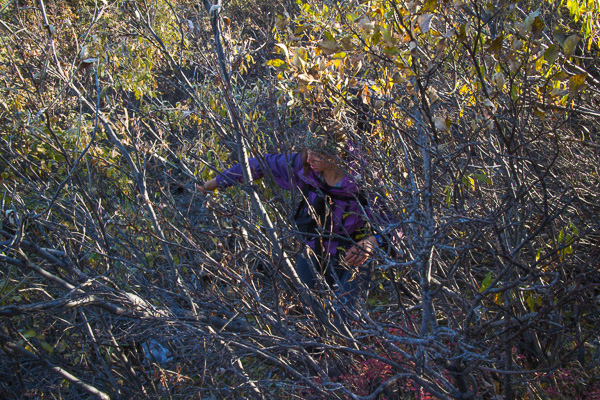
If it's not slide alder and willow, it can't be considered bushwhacking.
Halfway through the first day we came to a pass, still covered in several inches of snow from the storms a few days ago. Although we did not see a single living creature, there was evidence of them everywhere. Wolves chasing rabbits, apparently unsuccessfully, and enormous bear tracks which confirmed that we were indeed following bear trails most of the time. We started singing so as to minimize the chances of encountering “Ralph,” who by the size of his or her footsteps looked to be a mighty large animal. After a long descent through a forested hillside, we crossed hot springs creek, a cruel name for a glacially fed creek that was decidedly not hot, and set up camp. The next two days brought more of the same, and we began to feel at home in the brushy tundra, and the crisp but sunny autumn air.
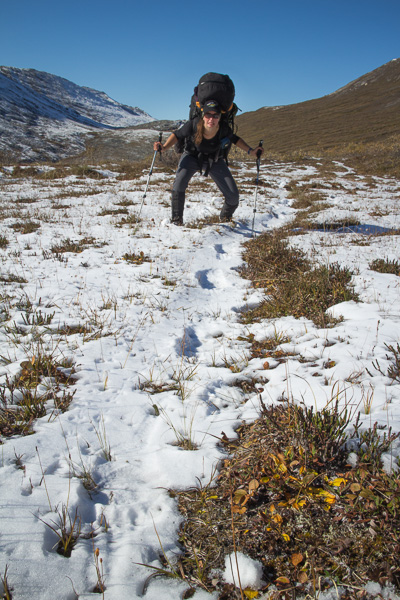
Aubrey, terrified that we might encounter the bear whose gigantic footsteps we were walking in.
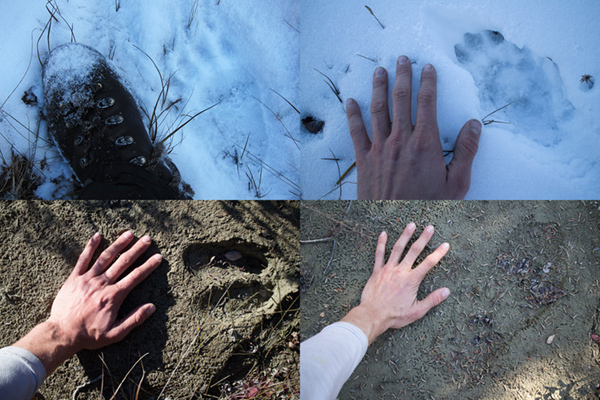
Bear prints, wolf prints, moose prints, and.... human prints!
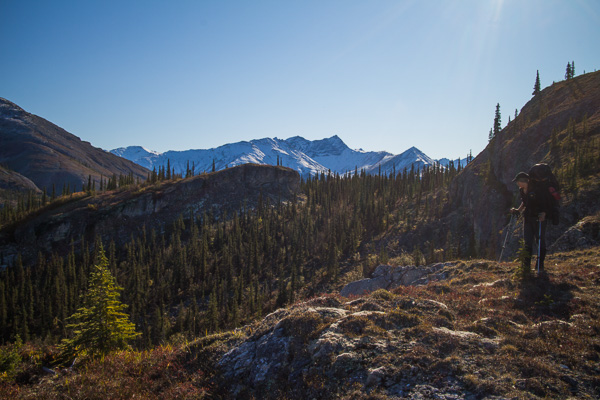
The vast alaskan wilderness of the brooks range, on a spectacularly clear day.
At last we reached Takahula Lake, a picturesque expanse of crystal clear water nestled in the southern foothills of the Brooks Range. Before I could reconsider, I stripped down and ran over the sandy beach into the frigid arctic water.. my first bath in 3 weeks. It was short lived, but oh so refreshing! Our pilot was due to arrive the following day anytime after 10 am. So we made ourselves comfortable, and started eating all the food that was left over. By the time he arrived at 5 pm the next day, we had just 2 packets of ramen, and enough beans, rice, and instant grits to last us 1-2 extra days, precisely what our target had been.
Seeing the plane touch down on the lake was both a moment of relief, and of extreme sadness, for it meant that we were headed back to civilization.
Click image for larger view!
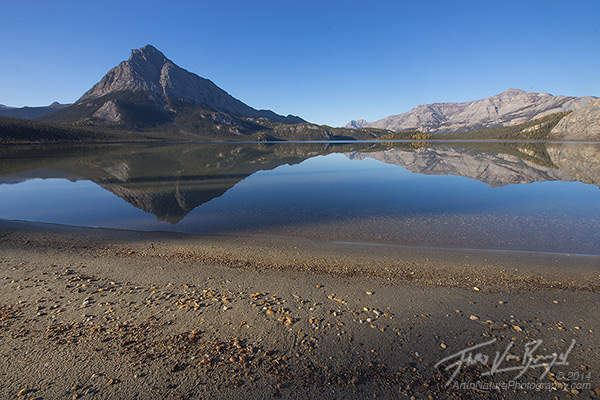
Shades of Blue : Prints Available
The late afternoon sun illuminates a tranquil scene on the shores of Takahula Lake, in Alaska's Gates of the Arctic National Park in the foothills of the Brooks Range.
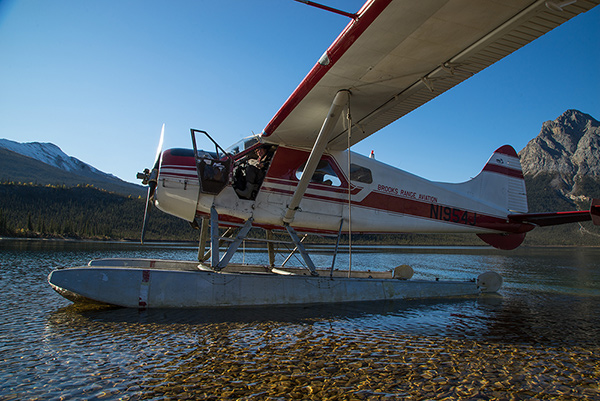
Brooks Range Aviation : Prints Available
Our float plane pilot, Jim, arrives at our pickup location on Takahula Lake on a spectacular afternoon. For our flights into and out of the Arrigetch Peaks we charted through Brooks Range Aviation - wonderful people and pilots!
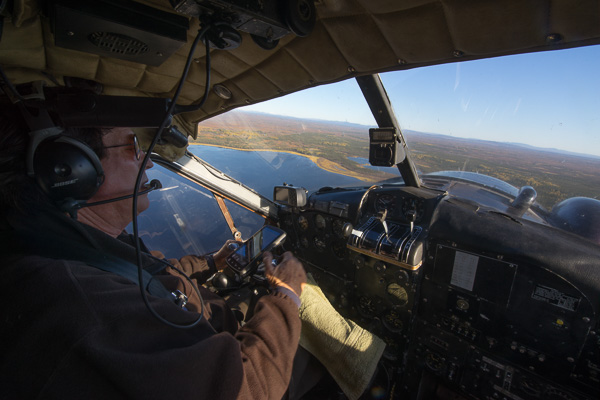
Jim, our pilot.
From a distance, mountains, forests, and other wild landscapes take on an organically textured tapestry of geology and ecology, which with every step becomes increasingly more detailed. Yet at no single point do the senses pick up on more than they can handle. The rate of new experiences is limited to the speed with which we can move ourselves under our own power. This incredible balance of complexity and simplicity may seem like a surprising coincidence, until of course, you recall that our sensory perception and mental processing evolved specifically to handle those environments. In the modern world, however, we find ourselves inundated by sensory stimulation that far exceeds our ability to process it all, leaving our brains overworked, under slept, and in many ways, uninspired. I think Jack London’s description of White Fang (a formerly wild wolf in the Yukon who has been taken prisoner in a human camp) captures this feeling perfectly.
He was homesick. He felt a vacancy in him, a need for the hush and quietude of the stream and the cave in the cliff. Life had become too populous… The restful loneliness of the only life he had known was gone. Here the very air was palpitant with life. It hummed and buzzed unceasingly. Continually changing its intensity and abruptly variant in pitch, it impinged on his nerves and senses, made him nervous and restless and worried him with a perpetual imminence of happening. – Jack London, White Fang
~ ~ ~
If you’re interested in making a trip to this area, but aren’t comfortable with planning and executing an expedition like this on your own, get in touch with my friend Carl Donohue. Carl is a professional guide in the area and leads backpacking trips through these incredible peaks: Arrigetch backpacking trips.
Tags: arctic, arrigetch peaks, brooks range, gates of the arctic, mountains, wilderness

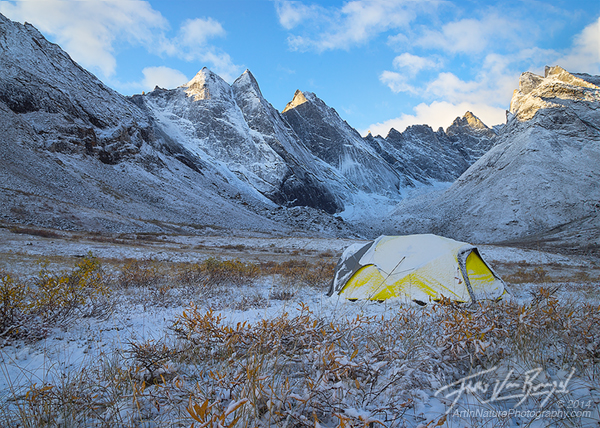


Simply incredible, Floris. I am a big fan of your work.
What an incredible trip. Your sense of adventure resonates somewhere inside me, I just need to channel my inner Floris and get off my ass. In four years (hopefully) I, too, will be finished with my PhD and my girlfriend finished with her PhD/DVM programs. We are already talking about taking an extended trip somewhere remote.
Your writing is outstanding, and the Jack London quotes were apropos. All your photos compliment beautifully the text and are fantastic in their own right. “On the Prowl” and “Claws of Winter” were exquisite, but I think “Northern Nights” stole my heart. I wanted to be there, in that tent, and I’m pretty sure I’ve had dreams of viewing the Northern Lights in exactly what you managed to capture.
I have so many questions about your itinerary; it would take me a day to put them all together. Congrats on pulling off such an EPIC (that word is so cliche, but in this instance its use is justified and should be mandatory) trip!
Thanks Sean! I’d be happy to answer some questions on the trip.
Truly epic journey and photos, Floris. Amazing work!
Floris,
Dude you killed it! Awesome images! Great trip.
I’m impressed you got all that food into the bear canister. Those things are a pain in the butt – it is hard to cram them with food, and they don’t fit all that well in backpacks either.
Wow, Floris. What an Amazing trip! The story was immersive and I enjoyed reading every word accompanied by the great documentary photographs. A few photographs stuck out to me artistically. I really enjoyed the aurora photograph from within the tent, as well as “Artic Angel”. The black and white image with the fingers of ice is also spectacular. Nicely done!
Your photos and write up perfectly capture the austere beauty of Arctic landscapes. I had the same observation about the Northern Lights during my trip to Swedish Arctic – to the naked eye the lights look pale and less colorful then the lights captured by a camera. Actually, even during dark nights the lights still look less colorful. During my trip there was around eight hours of dark nighttime, but with the naked eye I could not see the richness of colors (especially at the red end of the spectrum) that was captured by my camera.
Thanks folks! I really appreciate the kind words.
Ron – yea.. one canister is bad enough. Putting two in a backpack, plus everything else, is really obnoxious!
Victor – I’m glad I’m not the only one who doesn’t really see much color by naked eye!
Just unreal images Floris! I really appreciate that you took the time to write this whole article as well, I know it isn’t easy at all! I think my personal favorite image is “Arctic Angel” but “Snowy Arrigetch Morning” is truly spectacular as well.
Crazy amazing work and story, Floris! Love “Arctic Transitions,” “Claws of Winter,” and “Arctic Angel” (which must have been an absolutely surreal experience). Awesome all the way around, though, as we’ve come to enjoy from you. Thanks much for sharing your adventures!
Alot of hard work and an amazing trip captured with top class images. Incredible stuff Floris … I’m a big fan of your work! Inspirational…keep it up!
Stunning photography. Inspiring stuff.